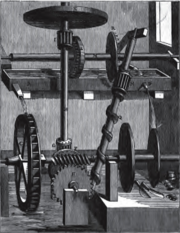A Perpetuum Motion (lat: eternal movement) device is a hypothetical machine which is said to be able to produce work indefinitely without energy sources or produces more energy than it consumes.
A great number of inventors claim they have built a perpetual motion machine, but none of them succeeded in proving this. Often these claims were made by fraudsters and scammers. Since such a device, if working, violated the laws of thermodynamics, it is also scientific consensus that it is impossible. Despite this fact, the pursuit of perpetual motion devices remains popular.
Classes of Perpetuum Motion devices
From a theoretical point of view, these machine are classified by the law they would violate:
- Perpetuum Motion device of the first kind: This machine produces energy without input, or more energy than it consumes, and therefore violates the first law of thermodynamics. This kind is also called "overunity" by its supporters.
- Perpetuum Motion device of the second kind: This machine converts heat to mechanical energy. Since this cools the environment, it cannot go on forever and violates the second law of thermodynamics.
- Perpetuum Motion device of the third kind: A machine that runs indefinitely without doing any work. The idea is that, if friction is completely removed, such a machine might run forever. And while it is impossible to achieve, it is however possible to come pretty close. Such devices have actually useful appliances e.g in the construction of flywheels.
Examples
- Hydrino
- Joe-Cell
- Perendev-Group
- Steorn
- Devices of Leslie Szabó
- Testatika
- Concepts of Claus Wilhelm Turtur
- Wasserauto
- Felix Würth AG
Weblinks
Versions of this article in other languages
- deutsch: Perpetuum Mobile
